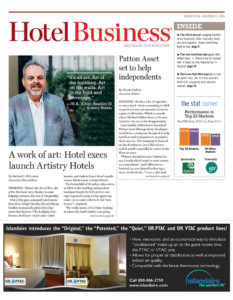VADODARA, INDIA—With more guests bringing their own devices, the hotel telephone has lessened in focus. But that doesn’t mean it’s not necessary for hoteliers to have robust communication solutions.
“If you go back a few years, communication in hotels was limited to internal and external calling. However, as tech-savvy customers are increasing, so are their demands,” said Ruchir Talati, marketing manager, Matrix Comsec, Telecom, India. “Guests expect a mobility solution in the hotels with internet connectivity and UC (unified communications) features. They want everything easy to use, be it making calls to other rooms, ordering food or taking important calls in the lobby or outside the room.”
To meet modern demands, Matrix recently launched communication solutions designed for properties that range from small, budget hotels to luxury hotels. Talati said that several factors were kept top-of-mind during the development process: customers’ requirements, a feature-rich solution, ease and simplicity, monetary value, competitiveness, quality, robustness and being future-ready.
For example, the newly launched Matrix SARVAM UCS offers integrated mobility and unified messaging, which help hotels improve collaboration among employees, according to Talati. With business applications for Android, iOS and Windows PC, employees can use their own devices for personal and professional purposes, no matter where they are.
Businesses can also benefit by eliminating the cost of business-owned devices, he said.
“Mobile has been a revolution in the new digital world. It is ever-changing and evolving and so are the ways of business in every industry, including hospitality,” said Talati. “Mobility is one of the important components of UC offerings. Hoteliers must select communication solutions that are future-centric and give advance mobility features with ever-evolving technology.”
Key features include: It’s scalable up to 2,500 users; has unified messaging and networks; is available on a variety of devices; enables IM and video calling; and offers voice mail and email to SMS and drag-and-drop conference calls.
“Today, the size of the mobile workforce is rapidly increasing. Employees can be anywhere: at the office, between appointments, on a business tour or working from home,” said Talati. “Unified communications can be an effective tool for extending collaborative technologies beyond the company network in order to better support today’s and future business activities and objectives.”
Talati noted there are questions a hotel should ask before choosing a solution. “The best solution should be technologically advanced and completely user friendly,” he said. “There are a few points to be considered: availability of the solution; service personnel in your region; integration with third-party PMS and CAS interfaces; advanced unified communications features; BYOD; after-sales services; and 24/7 support.
“Many hotels make a few mistakes when selecting communication solutions,” he said. One is they’re brand-conscious. “Many go with new systems just by trusting the brand value of that system’s company, which leads them to pay more money and compromise on the features and functionalities. Such consideration leads to high TCO (total cost of ownership) and less ROI.
Another mistake is being price-conscious. “Many go with systems that are economically cheap. If price is given the highest priority, the solution will be low in quality and functionalities, which will lead to customer dissatisfaction and negative impact on the hotel’s image,” said Talati. “Hotels should always go with value for the customers and money invested in the communication solution.” HB


